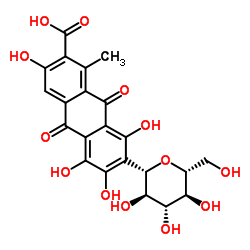Carmine

Carmine structure
|
Common Name | Carmine | ||
|---|---|---|---|---|
| CAS Number | 1390-65-4 | Molecular Weight | 492.386 | |
| Density | 1.9±0.1 g/cm3 | Boiling Point | 907.6±65.0 °C at 760 mmHg | |
| Molecular Formula | C22H20O13 | Melting Point | 136ºC dec | |
| MSDS | Chinese USA | Flash Point | 316.1±27.8 °C | |
Use of CarmineCarmine (Carmine red), a "semi-synthetic" dye, is a complex of aluminum and the natural dye Cochineal (Carminic acid). Cochineal is isolated from the native Mexican and South American insect. Carmine is a widely used "natural" food additive. Carmine provokes both an immediate hypersensitivity and a delayed systemic response with cutaneous expression[1][2]. |
| Name | carmine |
|---|---|
| Synonym | More Synonyms |
| Description | Carmine (Carmine red), a "semi-synthetic" dye, is a complex of aluminum and the natural dye Cochineal (Carminic acid). Cochineal is isolated from the native Mexican and South American insect. Carmine is a widely used "natural" food additive. Carmine provokes both an immediate hypersensitivity and a delayed systemic response with cutaneous expression[1][2]. |
|---|---|
| Related Catalog | |
| In Vitro | Carmine has been used in biological staining to demonstrate selectively nuclei, chromosomes or mucins, depending on the formulation[2]. |
| References |
[1]. Chandler W Rundle, et al. Contact Dermatitis to Carmine. Dermatitis. Sep/Oct 2018;29(5):244-249. |
| Density | 1.9±0.1 g/cm3 |
|---|---|
| Boiling Point | 907.6±65.0 °C at 760 mmHg |
| Melting Point | 136ºC dec |
| Molecular Formula | C22H20O13 |
| Molecular Weight | 492.386 |
| Flash Point | 316.1±27.8 °C |
| Exact Mass | 492.090393 |
| PSA | 256.66000 |
| LogP | 4.80 |
| Vapour Pressure | 0.0±0.3 mmHg at 25°C |
| Index of Refraction | 1.792 |
| Storage condition | Store at +5°C to +30°C. |
| Water Solubility | ammonium hydroxide: soluble1mg/mL |
CHEMICAL IDENTIFICATION
|
|
A new role of SNAI2 in postlactational involution of the mammary gland links it to luminal breast cancer development.
Oncogene 34 , 4777-90, (2015) Breast cancer is a major cause of mortality in women. The transcription factor SNAI2 has been implicated in the pathogenesis of several types of cancer, including breast cancer of basal origin. Here w... |
|
|
Transcriptome analysis of the hormone-sensing cells in mammary epithelial reveals dynamic changes in early pregnancy.
BMC Dev. Biol. 15 , 7, (2015) Alveoli, the milk-producing units of the mammary gland, are generated during pregnancy by collaboration of different epithelial cell types. We present the first analysis of transcriptional changes wit... |
|
|
Analysis and testing of biological stains--the Biological Stain Commission Procedures.
Biotech. Histochem. 77(5&6) , 237-275, (2002)
|
| (1S)-1,5-Anhydro-1-(7-carboxy-1,3,4,6-tetrahydroxy-8-methyl-9,10-dioxo-9,10-dihydro-2-anthracenyl)-D-glucitol |
| D-Glucitol, 1,5-anhydro-1-C-(7-carboxy-9,10-dihydro-1,3,4,6-tetrahydroxy-8-methyl-9,10-dioxo-2-anthracenyl)-, (1S)- |
| Carmine,high purity biol.stain,alum lake of carminic acid |
| MFCD00167028 |
| Carmine Red |
| Broseliquid |
| rougerecd |
| EINECS 215-724-4 |
| Carmine,certified,alum lake of carminic acid |
| Alum lake of carminic acid,Cochineal,Nacarat |
| 2-Anthracenecarboxylic acid, 7-β-D-glucopyranosyl-9,10-dihydro-3,5,6,8-tetrahydroxy-1-methyl-9,10-dioxo- |
| (1S)-1,5-Anhydro-1-(7-carboxy-1,3,4,6-tetrahydroxy-8-methyl-9,10-dioxo-9,10-dihydroanthracen-2-yl)-D-glucitol |
| CARMINIC ACID |

